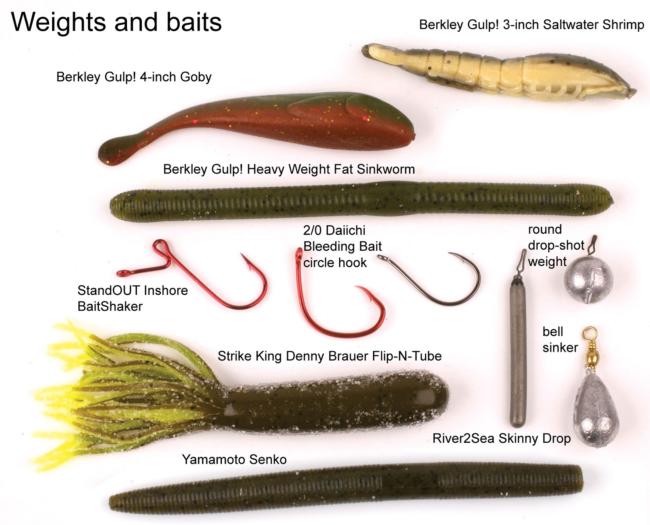Dropping in on reds
Catch redfish on a drop-shot rig
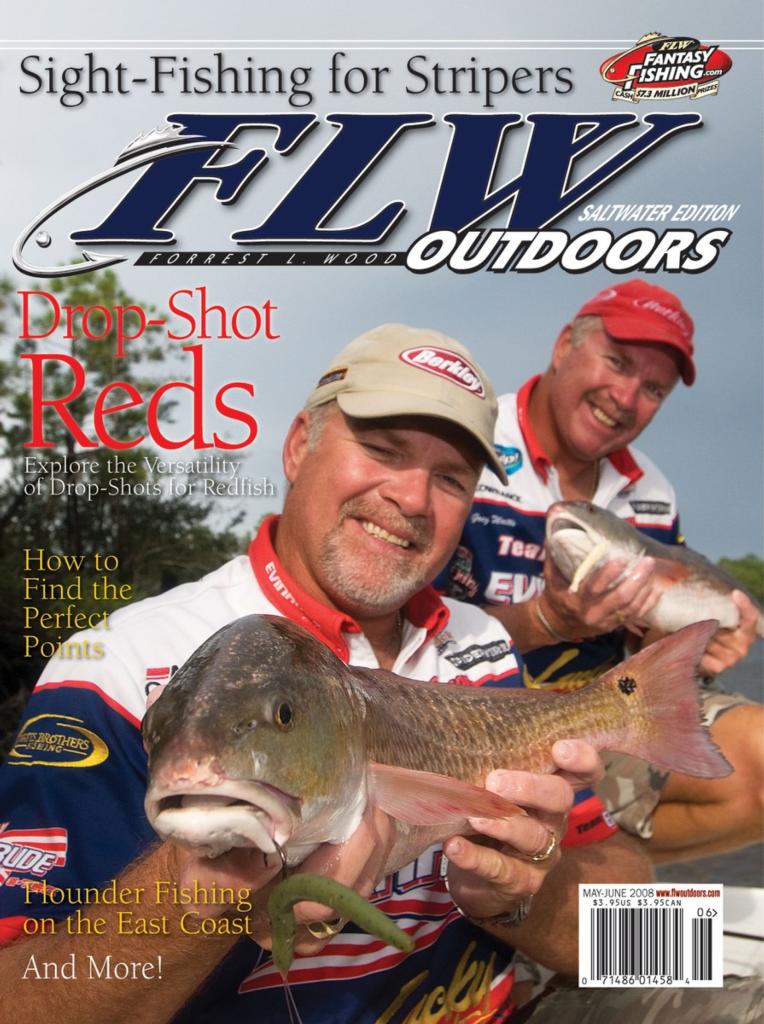
In October 2005, fishing pros Andre Moore and Kim Bain – both of Alabaster, Ala., and both of whom fish the Wal-Mart FLW Tour bass circuit – arrived in Orange Beach, Ala., for the annual Wal-Mart FLW Redfish Series Championship.
To say Moore and Bain, who are now married, were outgunned as a redfish team at the time is an understatement. Sure, both anglers had tangled with redfish on occasion and picked up a few pointers while delving into the FLW Redfish Series schedule in 2005. However, the couple’s redfish knowledge and experience paled in comparison to that of the full-time redfish pros and veteran saltwater guides in the championship.
But the redfish neophytes remained undaunted. After all, they came to the FLW Redfish Series events to take breaks from their day jobs as professional bass anglers.
“Kim and I wanted to try redfishing because it’s a lot of fun,” Moore said. “It’s more coastal, more laid back. Plus, we knew a lot of bass-fishing tactics cross over into redfishing.” Moore put this to the test at the championship.
After scouting the championship waters for several days with mixed results, Moore’s attention kept coming back to Perdido Pass, a deep, jetty-lined pass that connects Perdido Bay to the Gulf of Mexico, located just minutes from the championship launch site at Orange Beach.
“I was convinced there were redfish right there in the pass,” he reasoned. “It had all the right ingredients: deep water, current and structure. The problem was the current was really strong and the bottom was loaded with gnarly rocks.”
Moore has a healthy background in drop-shotting for bass in the deep, clear waters of the West. In his mind, he began to formulate a beefed-up drop-shot rig that would work in the pass.
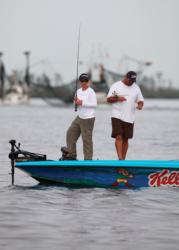 “I knew from my experience with drop-shotting on the Columbia River for bass that I needed to find some long, cylindrical-shaped sinkers – they work the best in current and rock,” Moore said. “And everything about the rig had to be upgraded: the line, the hook and the weight.”
“I knew from my experience with drop-shotting on the Columbia River for bass that I needed to find some long, cylindrical-shaped sinkers – they work the best in current and rock,” Moore said. “And everything about the rig had to be upgraded: the line, the hook and the weight.”
Moore and Bain scoured local tackle shops until they found exactly what they were looking for.
“We found some long `cigar weights,’ with eyelets on each end – the kind used for deep bait-trolling when kingfishing,” Moore recalled. “I bought every one they had from 1 to 3 ounces.”
Moore then spooled up a rod with 15-pound-test fluorocarbon, tied on a stout Owner Mosquito hook, sweetened it with a Berkley Gulp Saltwater Shrimp, and attached a 2-ounce cigar weight 2 feet down.
The result?
“It worked like a charm!” Moore exclaimed. “Kim and I started in the pass under the bridge every morning and caught our limit in an hour. There was a rock pile behind one of the concrete pilings that was key. We’d pitch up into the current behind the piling and just drift our rigs down with the current.”
The Moore-Bain duo finished in 12th place in the championship against 100 of the best redfish anglers in the country, thanks to their drop-shotting savvy.
Since that time, the drop-shot rig has found its way onto a lot more redfish pros’ rods, and not just in deep water, either. A handful of pros have been reaping the benefits of the drop-shot rig in the shallow flats, too.
Skinny-water drop-shot
One of the redfish pros who have perfected the shallow-water drop-shot is Ray Van Horn of Lutz, Fla. 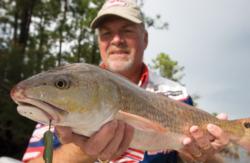 He and teammate C.A. Richardson of St. Petersburg, Fla., have been successfully drop-shotting the skinny flats of southwest Florida for several years.
He and teammate C.A. Richardson of St. Petersburg, Fla., have been successfully drop-shotting the skinny flats of southwest Florida for several years.
“We had it to ourselves for a while,” Van Horn said. “But this year we got put on television while using it and now the cat is out of the bag. We’re getting a few questions about the specifics of our flats drop-shot rig.”
What Van Horn and Richardson favor most about the drop-shot is how much casting distance and stealth it adds when fishing in the shallow flats of southwest Florida – a place where redfish are scared of their own shadows.
In fact, the team had JB Custom Rods in North Carolina build them a specific spinning rod, which they affectionately call the “Flats Cannon,” just for the technique. The Flats Cannon is 7 1/2 feet long and is the perfect action to hurl a 1/2-ounce drop-shot rig a country mile.
“We use the Flats Cannon with 10-pound-test braid,” Van Horn said. “And with a 1/2-ounce drop-shot weight you can literally cast all the line off your reel with it.”
The tactic is a way to overcome the distance limitations of casting a 1/8- or 1/4-ounce jighead.
“Redfish in southwest Florida are so pressured and skittish that if you get your boat within a cast and a half of them, they spook,” Van Horn continued. “We were in need of a way to fish for redfish without having to get anywhere near them, and the drop-shot rig was the answer. Now we can put whatever size weight we want on the thing and cast to redfish in the next county.”
The Florida team’s flats rig begins with the 10-pound-test braid being tied to a 4-foot section of 15-pound-test fluorocarbon leader. Then a 2/0 Daiichi Bleeding Bait circle hook is tied (with a Palomar knot) to the leader. About 12 inches down from the hook, Van Horn ties on a 1/2-ounce cylinder-shaped drop-shot weight made of lead.
The rig is completed with a Strike King Zero or a Strike King Denny Brauer Flip-N-Tube, either in watermelon-chartreuse or green-pumpkin, nose-hooked to the circle hook.
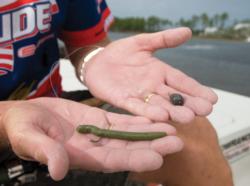 “We douse everything down with Carolina Lunker Sauce, which now comes in saltwater scents of shrimp, crab or menhaden,” Van Horn added. “The best thing about using the tube is that we can fill the hollow chamber full of shrimp or crab scent, sling it out there and just shake the rod tip occasionally to make the tube twitch over the grass while dispensing scent.”
“We douse everything down with Carolina Lunker Sauce, which now comes in saltwater scents of shrimp, crab or menhaden,” Van Horn added. “The best thing about using the tube is that we can fill the hollow chamber full of shrimp or crab scent, sling it out there and just shake the rod tip occasionally to make the tube twitch over the grass while dispensing scent.”
When FLW Redfish Series angler Bryan Watts of Lithia, Fla., was asked about the effectiveness of a shallow-water drop-shot rig for redfish, he could only shake his head while revealing its potential.
“It’s awesome,” he admitted. “You can put as much as 1 ounce of lead on the thing and get twice the casting distance as you would from a jighead.
“And the way the drop-shot presents the bait in the water is much different than a traditional jighead. Instead of the bait digging down in the sand and burying up in the grass on a jighead, it twitches and hovers just over the grass, giving it that weightless look. The extra distance combined with that weightless look allows us to make presentations that redfish have never seen, which is a huge bonus in pressured waters.”
Like Van Horn, Watts casts his flats rig with spinning gear for maximum distance. However, he opts for 15-pound-test Spiderwire braid, an oval-shaped dipsey sinker and Gulp Saltwater Shrimp in the 3-inch size.
Both redfish pros hardly ever use the shallow drop-shot rig as a search bait in practice.
“The drop-shot works best when you’ve already got your area staked out or you know where a group of reds is,” Van Horn said. “This is not something you go casting and retrieving down the bank like a spoon or jig. It’s made to cast out into a specific area and dead-stick in one spot where redfish are cruising.
“One place we throw it is into big groups of rafting mullet,” Van Horn said. “Redfish are known to follow mullet, but mullet can be spooky too. So we can launch this rig into a big school of mullet and wait for the redfish to sniff it out.”
“It’s awesome for areas where there is a lot of clingy moss or slimy grass,” Watts added. “Normally those kinds of areas bog a jighead down, making a perfect cast ineffective. With the drop-shot, the weight may get covered up, but the lure stays clean.”
As Moore and Bain discovered in Orange Beach, the drop-shot rig is effective on deep-water reds as well.
Both Van Horn and Watts also employ drop-shots in deeper inlets, passes, channels and cuts, sometimes probing water down to 25 feet.
“Basically, we just upgrade everything on the rig for deeper water and heavier current around rocks and pilings,” Watts said. “We go to casting tackle spooled with 30- or 40-pound-test braid, 30-pound fluorocarbon leader and up to 1 ounce of weight to get the bait to the bottom in the current.”
In terms of the length of leader from the hook to the weight in deeper water, it’s inconsequential when compared to getting the size of the weight right.
“Anywhere from 8 to 18 inches works fine; I don’t think it matters with redfish,” Watts offered. “More crucial than leader length to me is getting the size of your weight dialed in so it drifts in the current just right. You don’t want it too heavy and `sticking’ to the bottom, but it can’t be so light the current just sweeps it away. You want enough weight to get to the bottom, but then you want the current to drift it naturally – that’s very important.
“Tidal currents are always changing in intensity in passes, and I change my weight accordingly to make sure the drop-shot has a natural drift along the bottom,” Watts added.
Another tip Watts gave out in deep drop-shotting is to tie the weight on “half-heartedly” so it breaks off easily in a snag.
“That’s the beauty of a deep drop-shot rig over like a 1/2- or 3/4-ounce jighead,” Watts suggested. “When you get hung, the weight breaks off and you just tie on another one. Seldom does the actual hook and bait get hung.”
As for lures, Watts recommended staying with offerings that are 4 inches and smaller in deep-current situations.
“The bigger your lure, the more drag it has in deep current, which tends to foil a natural appearance,” he said. “We’ve learned it’s best to stick with about 3 1/2- to 4-inch baits that are straight and streamlined, such as the Gulp Saltwater Shrimp and a Berkley Gulp Saltwater Sinking Minnow in the 4-inch size. Also, we just started using the Berkley Gulp Gobies, which work well, too.”
One thing Moore specifically remembered about his drop-shot experience in Orange Beach is how applicable the drop-shot rig is for redfish.
“Given the way redfish relate to current, I think the drop-shot rig will eventually become a standard redfishing option, ranking right up there with jigs and spoons,” Moore said. “It’s a perfect tool for that species of fish in shallow or deep water.”
